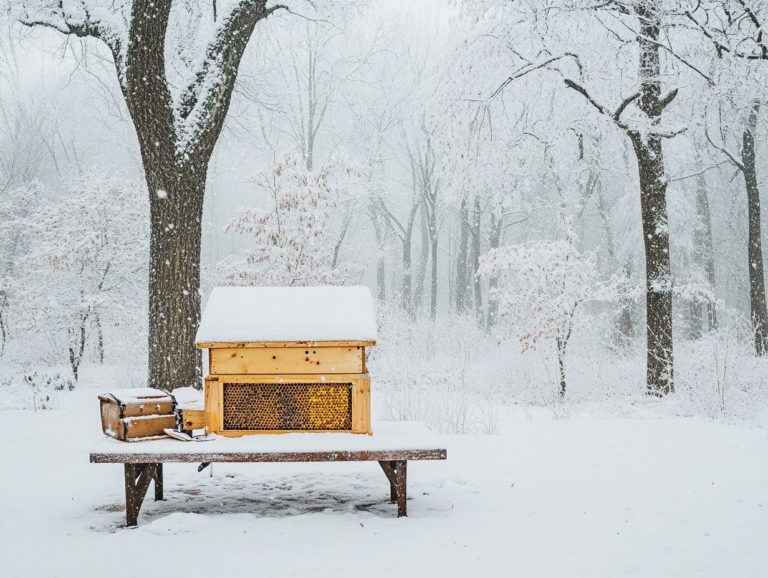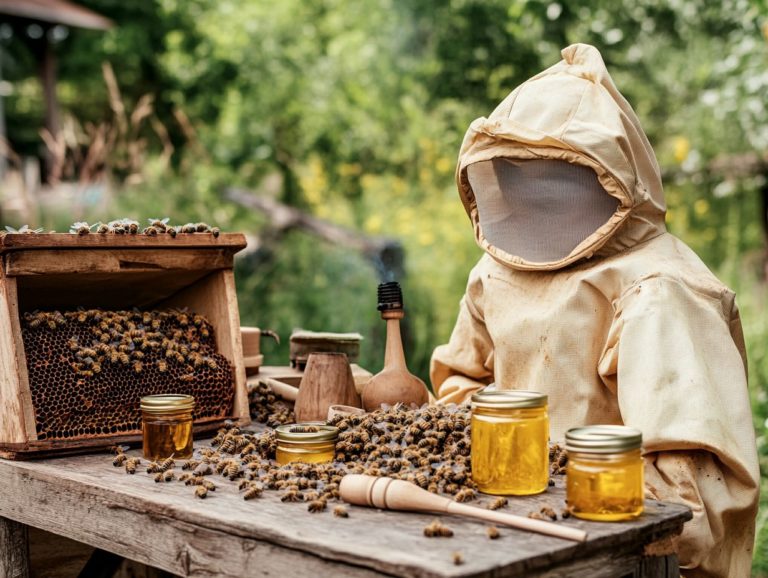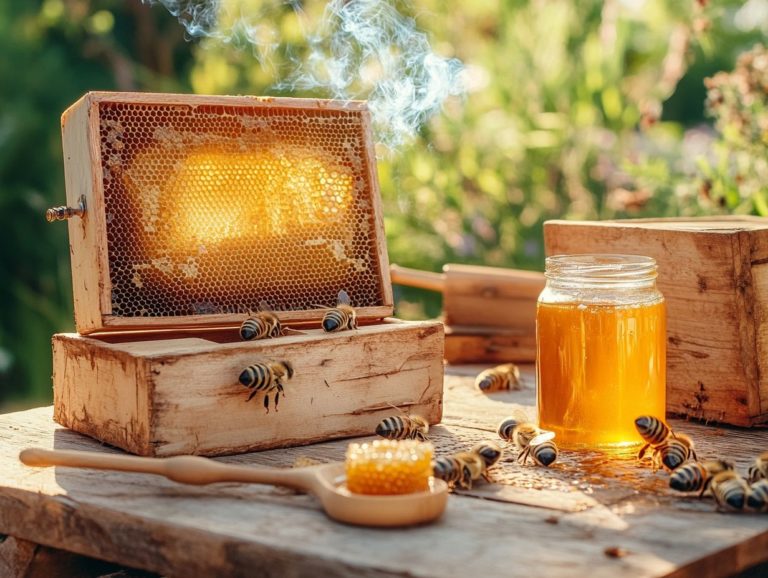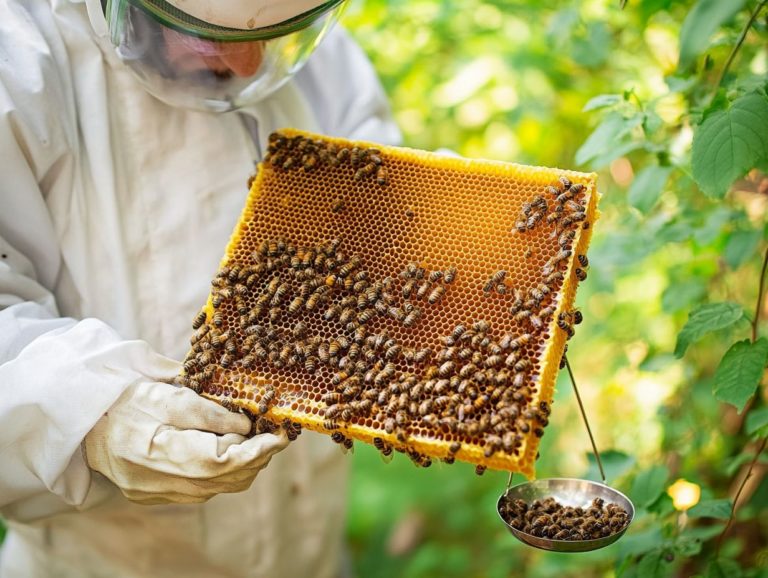How to Enhance Honey Production with Equipment
Are you excited to dive into the world of honey production? To achieve a fruitful harvest, understanding the basic beekeeping tools is important.
This guide will walk you through the vital components of a hive, the protective gear you’ll need, and the harvesting tools required to embark on your beekeeping journey. It will also provide insights on how to prepare, maintain, and effectively utilize your equipment to create an environment where your bees can flourish.
You will discover valuable tips to maximize your honey yield while considering crucial environmental factors. Are you prepared to transform into a honey-making expert? Let s delve in!
Don t miss out! Check our recommended beekeeping books to enhance your knowledge.
Contents
- Key Takeaways:
- What Equipment is Needed for Honey Production?
- How to Prepare Equipment for Honey Production?
- How to Use Equipment for Honey Production?
- What Are Some Tips for Maximizing Honey Production with Equipment?
- Frequently Asked Questions
- What are some common types of equipment used to enhance honey production?
- How can using a beehive enhance honey production?
- What is the purpose of a honey extractor in honey production?
- How can a smoker enhance honey production?
- Are there any other types of equipment that can enhance honey production?
- What are some best practices for using equipment to enhance honey production?
Key Takeaways:
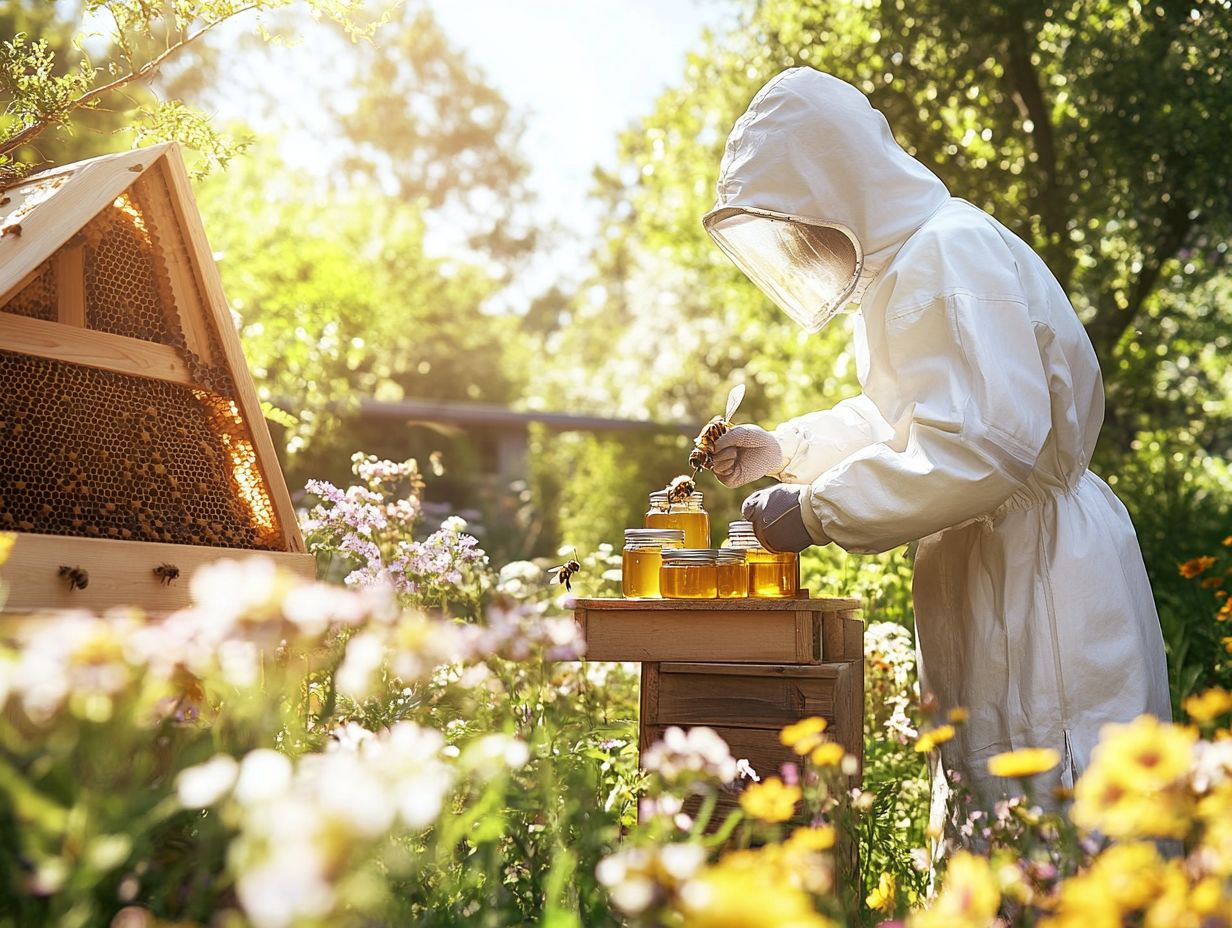
- Regular maintenance and proper storage of beekeeping equipment are crucial for successful honey production.
- Properly placing hives, considering nectar flow, and providing adequate nutrition for bees can help maximize honey production.
- Setting up the hive, monitoring bee health with beehive monitoring systems, and proper harvesting techniques are essential for using equipment effectively.
What Equipment is Needed for Honey Production?
As you embark on the rewarding journey of honey production, it s essential to arm yourself with the right beekeeping equipment to create optimal conditions for your bees and ensure a high-quality honey harvest.
The primary tools you ll need include hive tools, bee smokers, and various accessories that make hive checks and maintenance a breeze. Additionally, investing in beehive monitoring systems, queen rearing equipment, and automated honey extractors can streamline the honey harvesting process, simplifying the task for both novice and seasoned beekeepers alike.
By understanding the significance of each piece of equipment from frames and combs to protective gear and solar wax melters you will greatly enhance your honey production experience.
1. Hive Components
The components of a beehive nurture a healthy colony. They provide the necessary structures for bee growth and productivity. Key elements such as frames and combs lay the groundwork for honey storage and brood rearing. A queen excluder is a device that keeps the queen bee in specific areas of the hive, optimizing her egg-laying capabilities.
Whether you opt for a Langstroth hive or a Warre hive, grasping the specific functions and organization of these components is vital for successful beekeeping. For those interested in producing comb honey, understanding these hive types is particularly beneficial.
The Langstroth hive, with its movable frames, makes inspecting and managing your bee colony straightforward, which is why many beekeepers prefer it. Each frame can be easily removed and replaced, allowing you to monitor the bees activities and honey production with remarkable ease.
On the other hand, the Warre hive embraces a more natural philosophy, encouraging the bees to behave instinctively by allowing them to construct combs as they would in nature. The vertical stacking of boxes in a Warre hive motivates the bees to move upward, which can enhance ventilation and overall hive health.
Ultimately, how you arrange the frames and combs within these hives is pivotal in determining honey production, as it influences the bees’ efficiency in storing nectar and rearing brood, directly impacting the amount of honey you’ll harvest.
It’s also essential to consider the use of sensors and other technological aids to monitor the hive’s internal environment, ensuring optimal conditions.
2. Protective Gear
When you engage in beekeeping, wearing the right protective gear is essential for your safety and that of the bees.
Key items to consider include lightweight suits with breathable mesh and a bee smoker. The smoker emits cool smoke that calms the bees during hive checks and manipulations.
By using hive tools effectively alongside your protective gear, you can enhance both safety and efficiency while working within the hive.
For those new to beekeeping, it s vital to choose gear that is not just durable but also promotes adequate airflow. These suits come equipped with mesh panels that keep you cool and comfortable, even on those warmer days when the bees are particularly active.
Along with clothing, hive tools like smokers, scrapers, and brushes are essential for facilitating smooth interactions with your colonies. The smoker, for example, emits cool smoke that signals the bees to brace for potential threats, thereby reducing aggression and allowing for safer inspections.
Don’t forget to add a bee brush to your toolkit; it’s crucial for gently moving bees off the combs. By combining these elements, you create a comprehensive strategy to protect both yourself and your buzzing companions, ensuring a harmonious beekeeping experience.
3. Harvesting Equipment
Harvesting equipment is at the heart of your beekeeping journey, playing a pivotal role in shaping the efficiency and quality of your honey production.
Automated honey extractors, or machines that help extract honey quickly, revolutionize the extraction process by harnessing centrifugal force a method that spins honey out of the comb using fast circular motion. This ultimately saves you valuable time and labor.
When you invest in high-quality beekeeping equipment, you not only elevate your harvesting experience, but also ensure that your honey retains its natural essence and exquisite flavors.
As you explore your options, it s essential to consider the diverse types of harvesting equipment available. Whether it s manual extractors for smaller operations or larger, more sophisticated models designed for commercial production, there s a perfect fit for your needs.
Automated honey extractors bring remarkable advantages, including shorter processing times and enhanced quality control, helping you maintain the delicate flavor profiles that discerning consumers crave.
When selecting the right equipment, take the time to assess your production scale, storage capacity, and budget. Ensuring that your choice aligns with your specific requirements is key.
Ultimately, the method you choose for harvesting is not just about efficiency; it also profoundly influences the purity and taste of your final honey product. Thoughtful decisions in this area are essential for successful beekeeping, allowing you to produce the finest honey possible.
How to Prepare Equipment for Honey Production?
Preparing your beekeeping equipment for honey production is not just important; it s crucial for your success! It all starts with thorough cleaning and sanitizing to create a healthy environment for your bees, which in turn leads to better honey yields.
Every piece of your beekeeping arsenal hive tools, automated honey extractors, and protective gear needs meticulous attention to detail to eliminate any contaminants or residues that could jeopardize your bees or compromise the quality of your honey.
Proper storage is equally crucial. By keeping your equipment dry and organized, you re not only extending its lifespan but also ensuring it functions optimally when you need it most.
Regular maintenance is the key to success, allowing everything from your beehive monitoring systems to frames and combs to operate efficiently throughout the entire honey production season.
Take these steps, and you ll be well on your way to a bountiful harvest! Follow these steps to set yourself up for a honey harvest you ll be proud of!
1. Cleaning and Sanitizing Equipment
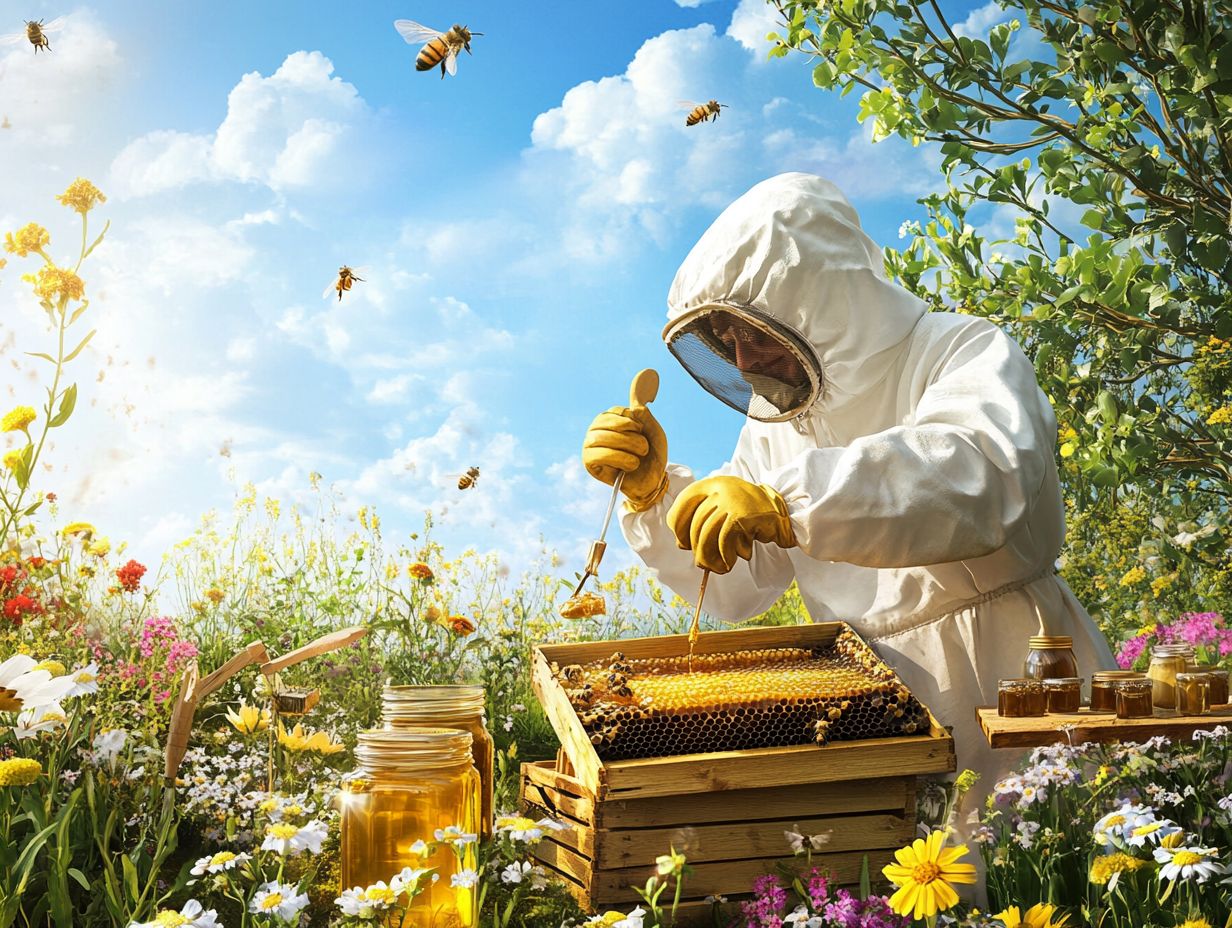
Cleaning and sanitizing your beekeeping equipment is absolutely essential to prevent diseases and safeguard the health of your bee colony. Make sure to clean everything from hive tools to surfaces that touch your bees for their health!
This important process should encompass all surfaces that may come into contact with your bees or honey. By utilizing hot water, soap, and food-grade sanitizers which are safe for food production and won’t harm your bees you can effectively eliminate harmful pathogens without compromising the integrity of your equipment.
Maintaining a pristine environment is crucial to warding off diseases that could devastate your colonies. Establish a routine cleaning schedule now to protect your bees! It s wise to clean after each use or during seasonal transitions. Ensure that all your tools are thoroughly rinsed to eliminate any harmful residues.
You might also consider using non-toxic cleaning agents, like vinegar or baking soda, as these are safe for both your bees and the environment. Don’t overlook the importance of regularly inspecting queen rearing equipment and other specialized tools to ensure they are free from contaminants.
By prioritizing these best practices, you not only bolster the health of your colonies but also embrace sustainable beekeeping practices that honor the natural habitat and lifecycle of the bees.
2. Proper Storage of Equipment
Properly storing your beekeeping equipment is essential for extending its lifespan and ensuring it remains in optimal condition for honey production. Keep your gear in a dry, sheltered area, away from extreme temperatures, pests, and moisture that could lead to deterioration.
By labeling boxes and utilizing organized storage solutions, you can easily access your hive tools and accessories whenever you need them. Consider investing in waterproof containers for sensitive items like gloves and suits to protect them from mold and mildew.
Regularly inspect your storage area for any signs of insect infestations or leaks. Establishing a clear labeling system accelerates your preparation process and reduces the risk of misplacing crucial equipment while managing your hives.
Think about categorizing items by their frequency of use or type to ensure that everything from smokers to honey extractors and other essential apiary equipment is within arm’s reach whenever required.
3. Regular Maintenance of Equipment
Regular maintenance of your beekeeping equipment, including hive tools and accessories, is vital for prolonging its life and ensuring optimal performance. This maintenance extends to all aspects of your apiary, from frames and combs to bee smokers and automated honey extractors.
Regularly inspecting and repairing your equipment helps prevent small issues from becoming larger problems, ensuring smooth and efficient operations. Regular maintenance is crucial to ensure everything operates smoothly and contributes to your honey production success.
Conduct routine hive checks to spot issues like wear and tear on frames, combs, and propolis, as well as ensuring that your automated honey extractors and other tools are functioning properly. Schedule these inspections to prevent potential problems that might adversely affect bee health, honey yield, and the longevity of your Langstroth hive.
Taking proper care of your equipment involves assessing the condition of your hives, which can be compromised by weather conditions or pests. It’s important to frequently clean and sterilize your tools to eliminate any pathogens that could harm your colonies.
Keep an eye out for cracks or warping in wooden components, ensuring that they remain sound and well-insulated. Regularly check your protective gear to maintain safety during hive management.
By recognizing the early signs of wear and addressing them promptly, you can create an environment that fosters thriving bee colonies and maximizes your honey output throughout the season.
How to Use Equipment for Honey Production?
To excel in honey production, you need a well-rounded understanding of ways to keep bees along with hands-on experience with your tools. It s essential to know how to set up your hive correctly, monitor the health of your bees, and efficiently harvest honey. This will maximize your production while ensuring the well-being of your colony.
Each piece of equipment, whether it’s hive tools or automated honey extractors, plays a crucial role in this process. By leveraging these tools effectively, you can boost your honey yield with techniques for increasing honey production and promote sustainable beekeeping practices.
1. Setting Up the Hive
Setting up your hive is a crucial first step in the beekeeping journey. It demands careful planning and consideration of various environmental factors. Choosing the right location is essential; your hive should bask in adequate sunlight, have protection from the wind, and be near a reliable source of nectar and pollen, whether you are using a Langstroth hive or a Warre hive.
Utilizing the right hive tools allows you to assemble the components correctly. This ensures a safe and welcoming environment for your bee colony.
As you embark on this endeavor, consider your surroundings, including the availability of nearby blossoms that offer consistent foraging opportunities throughout the seasons. Using a queen excluder helps you manage your hive more effectively.
A well-placed hive should not only be close to flowering plants but also shielded from harsh weather conditions, such as strong winds or heavy rain, which can disrupt the bees’ activities.
Elevating the hive is another smart move. It helps prevent moisture buildup that could jeopardize the health of your colony. By taking all these factors into account, you can create a thriving environment that promotes bee productivity and longevity.
2. Monitoring Bee Health
Monitoring bee health is essential for successful honey production. The well-being of your bees directly impacts both the yield and quality of the honey. By implementing beehive monitoring systems, you can track crucial indicators of bee health, such as temperature, humidity, and activity levels. This gives you valuable insights for timely hive checks, especially if you are a beginner beekeeper.
Staying vigilant about the environmental factors that influence bee behavior and health is equally important. This allows you to address any issues without delay, whether you are using a Langstroth hive, Warre hive, or any other type of hive.
Advanced tools like infrared cameras and acoustic sensors are invaluable for assessing bee activity and identifying potential stressors within the hive. While regular inspections are crucial for detecting diseases or pests, they also deepen your understanding of the colony s dynamics.
By merging traditional methods with innovative technologies, you can elevate your beekeeping practices. This leads to healthier colonies and, ultimately, superior honey. If you’re interested in learning how to increase your honey production, emphasizing a blend of technology and hands-on experience will significantly enhance your beekeeping standards. Are you ready to boost your hive’s health today?
3. Harvesting Honey
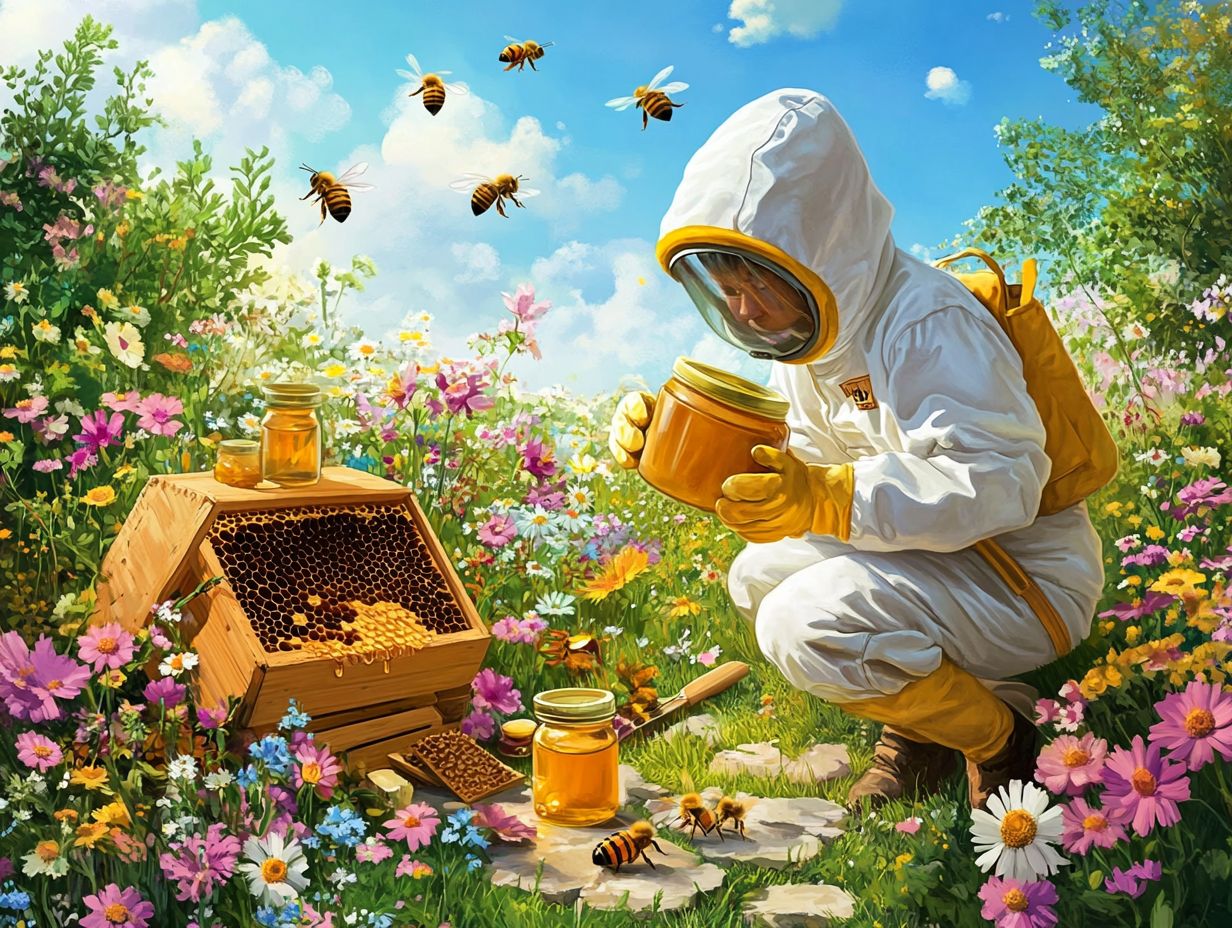
Harvesting honey rewards your hard work as a beekeeper! It requires the right techniques and equipment to ensure a successful yield. By using automated honey extractors, you can simplify the extraction process. These machines spin honeycomb to collect honey without damaging it. Proper use of hive tools during the harvest minimizes disruption to your bee colony, helping to maintain a productive and healthy environment.
Timing is key; aim to harvest on warm, sunny days when the bees are less active. As you go through the process, don t forget your protective gear it s essential for a smooth harvest! Approach the hives with a calm demeanor to avoid agitating the bees.
Once you’ve collected the honey frames, uncapping them carefully with a hot knife or capping fork is crucial to ensure minimal mess.
When using automated extractors, follow the manufacturer’s guidelines to maximize efficiency while minimizing stress for the bees. After extraction, be sure to filter the honey and store it in clean, sanitized containers, prioritizing hygiene to preserve your sweet reward for months. Handling the bees gently throughout the process nurtures a harmonious relationship between you and your buzzing friends.
What Are Some Tips for Maximizing Honey Production with Equipment?
Plan wisely to boost your honey production! Engage in strategic planning and leverage various beekeeping equipment to enhance the health and productivity of your bee colonies.
Regular hive checks are essential to ensure your bees are thriving. Pay attention to environmental factors such as the availability of flowers that bees collect nectar from and weather conditions that can influence your honey yields.
Using a bee smoker helps keep your bees calm during inspections and harvesting. This contributes to a more successful honey production process.
1. Properly Place Hives
Properly placing your hives is crucial for maximizing honey production and ensuring the health of your bees. Consider environmental factors like sunlight exposure, wind protection, and proximity to flowering plants when selecting the ideal location for your hives.
A well-positioned apiary grants your bees access to plentiful nectar sources and provides shelter from harsh weather conditions, leading to higher honey yields.
When choosing your site, consider factors such as soil drainage and avoid areas prone to flooding. Standing water can be detrimental to your colonies.
It’s wise to position the hives away from heavy human activity and disturbances. This fosters a calmer atmosphere for your bees.
Evaluate the local flora to strategically place your hives where bees can flourish among diverse plant species, resulting in richer honey varieties.
By prioritizing these considerations, you can significantly enhance productivity while cultivating a sustainable environment that supports the longevity and health of your bee populations.
2. Regularly Inspect and Maintain Equipment
Regularly inspecting and maintaining your equipment is crucial to ensuring that all your beekeeping tools and systems are functioning well for honey production. Check your hive tools for wear, ensure your automated honey extractors are working well, and monitor the condition of your frames and combs.
Adopting a routine of regular check-ups on your equipment extends its lifespan and boosts the overall health and productivity of your bee colonies.
Implement a systematic checklist to address potential issues before they grow into significant problems. This is particularly important for beginner beekeepers who are still learning to identify potential risks.
- Inspect the hive boxes for any signs of rot or damage.
- Ensure that screens and entrances are clear of debris.
- Check the functionality of feeders and water sources.
By closely examining the health of your bees and ensuring that every component supports their needs, you ll foster stronger colonies and achieve better honey yields. Consistency in these inspections will significantly enhance both the efficiency and output of your honey production.
3. Provide Adequate Nutrition for Bees
Providing adequate nutrition for your bees is essential for maximizing honey production and maintaining the overall health of your colony throughout the season. Pay close attention to the environmental factors that influence nectar flow and pollen availability, supplementing your bees’ diets with sugar syrup or protein patties when necessary.
A well-nourished bee colony is not only more productive but also more resilient, capable of producing high-quality honey.
Understand the specific needs of your bees at different life stages to refine your nutrition strategy. During periods of dearth, especially in late winter and early spring, implement nutritional reserves to prevent starvation and encourage colony growth.
Offer high-energy feeds and ensure an adequate protein source. This leads to improved brood development and stronger, more vigorous hives. Healthy bees are better equipped to gather nectar and pollen and exhibit greater resistance to diseases. Nutrition is a fundamental pillar in the art and science of successful beekeeping.
Frequently Asked Questions
Start applying these tips today to watch your honey production soar!
What are some common types of equipment used to enhance honey production?
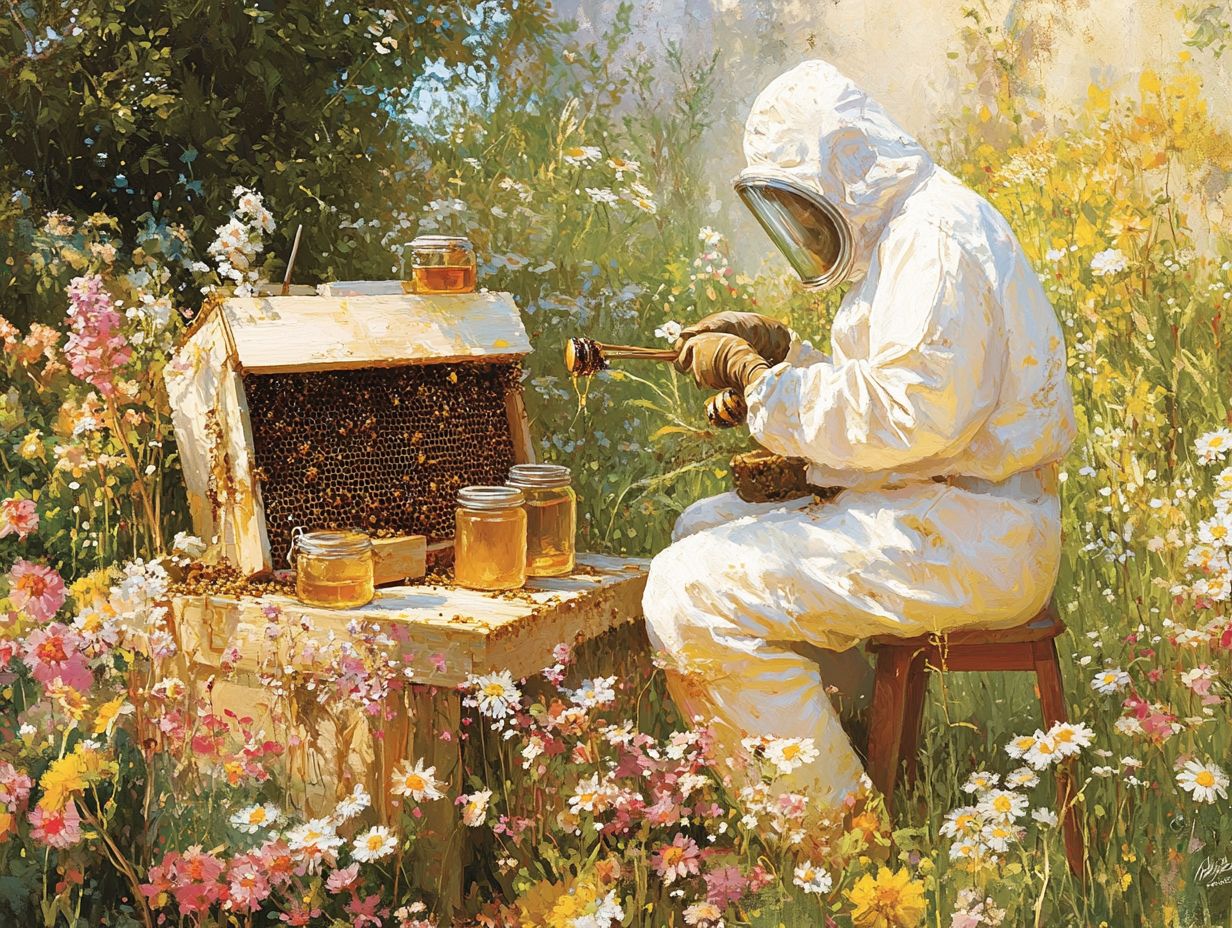
Common equipment for boosting honey production includes beehives, honey extractors, smokers, and frames and combs.
How can using a beehive enhance honey production?
A beehive, like a Langstroth or Warre hive, gives bees a cozy, organized home to thrive! This results in higher honey yields.
What is the purpose of a honey extractor in honey production?
A honey extractor pulls honey from the comb without damaging it. This makes the process efficient and less disruptive for the bees.
A queen excluder ensures that only worker bees access the honey frames.
How can a smoker enhance honey production?
A smoker calms bees during honey production. This helps beekeepers work with the hives safely and reduces bee sting risks.
Are there any other types of equipment that can enhance honey production?
Other equipment, like frames, combs, bee suits, and hive tools, can also boost honey production.
What are some best practices for using equipment to enhance honey production?
Best practices include keeping equipment well-maintained, sterilizing it to avoid contamination, and picking tools made for honey production.


